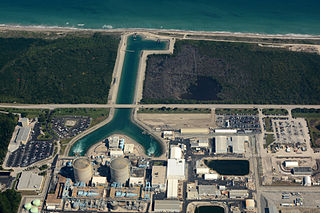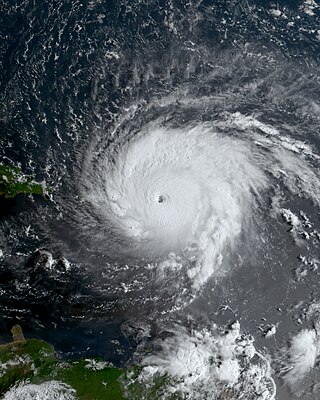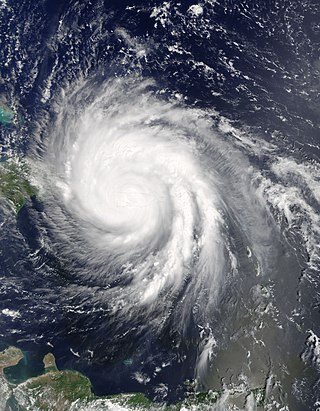Related Research Articles

Hollywood is a city in Broward County, Florida, United States. It is a suburb in the Miami metropolitan area, which was home to 6.14 million people as of the 2020 census. The population of Hollywood was 153,067 as of 2020, making it the third-largest city in Broward County, the fifth-largest in the Miami metropolitan area, and the 12th-largest in Florida. The average temperature is between 69 and 83 °F.
The Saffir–Simpson hurricane wind scale (SSHWS) classifies hurricanes—which in the Western Hemisphere are tropical cyclones that exceed the intensities of tropical depressions and tropical storms—into five categories distinguished by the intensities of their sustained winds. This measuring system was formerly known as the Saffir–Simpson hurricane scale, or SSHS.

Hurricane Isabel was the strongest Atlantic hurricane since Mitch, and the deadliest, costliest, and most intense hurricane in the 2003 Atlantic hurricane season. Hurricane Isabel was also the strongest hurricane in the open waters of the Atlantic, both by wind speed and central pressure, before being surpassed by hurricanes Irma and Dorian in 2017 and 2019, respectively. The ninth named storm, fifth hurricane, and second major hurricane of the season, Isabel formed near the Cape Verde Islands from a tropical wave on September 6, in the tropical Atlantic Ocean. It moved northwestward, and within an environment of light wind shear and warm waters, it steadily strengthened to reach peak winds of 165 mph (266 km/h) on September 11. After fluctuating in intensity for four days, during which it displayed annular characteristics, Isabel gradually weakened and made landfall on the Outer Banks of North Carolina, with winds of 105 mph (169 km/h) on September 18. Isabel quickly weakened over land and became extratropical over western Pennsylvania on the next day. On September 20, the extratropical remnants of Isabel were absorbed into another system over Eastern Canada.

St. Lucie Nuclear Power Plant is a twin nuclear power station located on Hutchinson Island, near Port St. Lucie in St. Lucie County, Florida. Both units are Combustion Engineering pressurized water reactors. Florida Power & Light commissioned the station in 1976 and continues to operate the station. Minor shares of Unit 2 are owned by the Florida Municipal Power Agency (8.81%) and the Orlando Utilities Commission (6.08%).

Hurricane Rita was the most intense tropical cyclone on record in the Gulf of Mexico and the fourth-most intense Atlantic hurricane ever recorded. Part of the record-breaking 2005 Atlantic hurricane season, which included three of the top ten most intense Atlantic hurricanes in terms of barometric pressure ever recorded, Rita was the seventeenth named storm, tenth hurricane, and fifth major hurricane of the 2005 season. It was also the earliest-forming 17th named storm in the Atlantic until Tropical Storm Rene in 2020. Rita formed near The Bahamas from a tropical wave on September 18, 2005 that originally developed off the coast of West Africa. It moved westward, and after passing through the Florida Straits, Rita entered an environment of abnormally warm waters. Moving west-northwest, it rapidly intensified to reach peak winds of 180 mph (285 km/h), achieving Category 5 status on September 21. However, it weakened to a Category 3 hurricane before making landfall in Johnson's Bayou, Louisiana, between Sabine Pass, Texas and Holly Beach, Louisiana, with winds of 115 mph (185 km/h). Rapidly weakening over land, Rita degenerated into a large low-pressure area over the lower Mississippi Valley by September 26th.

Cyclone mitigation encompasses the actions and planning taken before a tropical cyclone strikes to mitigate damage and injury from the storm. Knowledge of tropical cyclone impacts on an area help plan for future possibilities. Preparedness may involve preparations made by individuals as well as centralized efforts by governments or other organizations. Tracking storms during the tropical cyclone season helps individuals know current threats. Regional Specialized Meteorological Centers and Tropical Cyclone Warning Centers provide current information and forecasts to help individuals make the best decision possible.

Hurricane Wilma was the most intense tropical cyclone ever recorded in the Atlantic basin, and the second-most intense tropical cyclone recorded in the Western Hemisphere, after Hurricane Patricia in 2015. Part of the record-breaking 2005 Atlantic hurricane season, which included three of the ten most intense Atlantic hurricanes in terms of barometric pressure, Wilma was the twenty-second storm, thirteenth hurricane, sixth major hurricane, fourth Category 5 hurricane, and the second-most destructive hurricane of the 2005 season. Its origins came from a tropical depression that formed in the Caribbean Sea near Jamaica on October 15, headed westward, and intensified into a tropical storm two days later, which abruptly turned southward and was named Wilma. Wilma continued to strengthen, and eventually became a hurricane on October 18. Shortly thereafter, explosive intensification occurred, and in only 24 hours, Wilma became a Category 5 hurricane with wind speeds of 185 mph (298 km/h).

The effects of Hurricane Wilma in Florida resulted in the storm becoming one of the costliest tropical cyclones in Florida history. Wilma developed in the Caribbean Sea just southwest of Jamaica on October 15 from a large area of disturbed weather. After reaching tropical storm intensity on October 17 and then hurricane status on October 18, the system explosively deepened, peaking as the strongest tropical cyclone ever recorded in the Atlantic basin. Wilma then slowly weakened while trekking to the northwest and fell to Category 4 intensity by the time it struck the Yucatán Peninsula on October 22. Thereafter, a strong cold front swept the storm northeastward into Florida on October 24, with landfall occurring near Cape Romano as a Category 3 hurricane with winds of 120 mph (190 km/h). Wilma continued rapidly northeastward into the Atlantic Ocean and became extratropical on October 26.
The effects of climate change in Florida are attributable to man-made increases in atmospheric carbon dioxide. Floridians are experiencing increased flooding due to sea level rise, and are concerned about the possibility of more frequent or more intense hurricanes.

Hurricane Ike was a powerful tropical cyclone that swept through portions of the Greater Antilles and Northern America in September 2008, wreaking havoc on infrastructure and agriculture, particularly in Cuba and Texas. Ike took a similar track to the 1900 Galveston hurricane. The ninth tropical storm, fifth hurricane, and third major hurricane of the 2008 Atlantic hurricane season, Ike developed from a tropical wave west of Cape Verde on September 1 and strengthened to a peak intensity as a Category 4 hurricane over the open waters of the central Atlantic on September 4 as it tracked westward. Several fluctuations in strength occurred before Ike made landfall on eastern Cuba on September 8. The hurricane weakened prior to continuing into the Gulf of Mexico, but increased its intensity by the time of its final landfall in Galveston, Texas, on September 13 before becoming an extratropical storm on September 14. The remnants of Ike continued to track across the United States and into Canada, causing considerable damage inland, before dissipating on the next day.

Lindy Boggs Medical Center, formerly known as Mercy Hospital and also known as Lindy Boggs Hospital, is a now-abandoned 187-bed acute care hospital operated by Tenet Healthcare located in Mid-City New Orleans, Louisiana. The hospital provided many services, including emergency care, critical care, and organ transplantation services.

The 2017 Atlantic hurricane season was a devastating and extremely active Atlantic hurricane season, and the costliest on record, with a damage total of at least $294.92 billion (USD). The season featured 17 named storms, 10 hurricanes, and 6 major hurricanes. Most of the season's damage was due to hurricanes Harvey, Irma, and Maria. Another notable hurricane, Nate, was the worst natural disaster in Costa Rican history. These four storm names were retired following the season due to the number of deaths and amount of damage they caused.

Hurricane Joaquin was a powerful tropical cyclone that devastated several districts of The Bahamas and caused damage in the Turks and Caicos Islands, parts of the Greater Antilles, and Bermuda. It was also the strongest Atlantic hurricane of non-tropical origin recorded in the satellite era. The tenth named storm, third hurricane, and second major hurricane of the 2015 Atlantic hurricane season, Joaquin evolved from a non-tropical low to become a tropical depression on September 28, well southwest of Bermuda. Tempered by unfavorable wind shear, the depression drifted southwestward. After becoming a tropical storm the next day, Joaquin underwent rapid intensification, reaching hurricane status on September 30 and Category 4 major hurricane strength on October 1. Meandering over the southern Bahamas, Joaquin's eye passed near or over several islands. On October 3, the hurricane weakened somewhat and accelerated to the northeast. Abrupt re-intensification ensued later that day, and Joaquin acquired sustained winds of 155 mph (250 km/h), just short of Category 5 strength.

Hurricane Floyd in 1999 threatened Florida as a major hurricane roughly three times as large as Hurricane Andrew. Floyd originated from a tropical wave well east of the Lesser Antilles on September 7. While approaching the Bahamas, the storm strengthened significantly between September 12 and September 13. On the latter day, Floyd peaked as a strong Category 4 hurricane on the Saffir–Simpson scale. However, upon moving closer to the Bahamas, the storm fluctuated in intensity between a Category 3 and a Category 4 hurricane. A subtropical ridge eroded by a mid- to upper-tropospheric trough over the eastern United States caused Floyd to curve northwestward over the Abaco Islands and later to northeast, avoiding a potentially catastrophic landfall in Florida. The storm made its closest approach to Florida early on September 15, passing about 110 mi (180 km) east of Cape Canaveral.

Hurricane Irma was an extremely powerful Cape Verde hurricane that caused widespread destruction across its path in early September 2017. Irma was the first Category 5 hurricane to strike the Leeward Islands on record, followed by Maria two weeks later. At the time, it was considered the most powerful hurricane on record in the open Atlantic region, outside of the Caribbean Sea and Gulf of Mexico, until it was surpassed by Hurricane Dorian two years later. It was also the third-strongest Atlantic hurricane at landfall ever recorded, just behind the 1935 Labor Day Hurricane and Dorian. The ninth named storm, fourth hurricane, second major hurricane, and first Category 5 hurricane of the extremely active 2017 Atlantic hurricane season, Irma caused widespread and catastrophic damage throughout its long lifetime, particularly in the northeastern Caribbean and the Florida Keys. It was also the most intense hurricane to strike the continental United States since Katrina in 2005, the first major hurricane to make landfall in Florida since Wilma in the same year, and the first Category 4 hurricane to strike the state since Charley in 2004. The word Irmageddon was coined soon after the hurricane to describe the damage caused by the hurricane.

Hurricane Maria was a deadly Category 5 hurricane that devastated the northeastern Caribbean in September 2017, particularly in the U.S. territory of Puerto Rico, which accounted for 2,975 of the 3,059 deaths. It is the deadliest and costliest hurricane to strike the island of Puerto Rico, and is the deadliest hurricane to strike the country of Dominica and the territory of the U.S. Virgin Islands. The most intense tropical cyclone worldwide in 2017, Maria was the thirteenth named storm, eighth consecutive hurricane, fourth major hurricane, second Category 5 hurricane, and deadliest storm of the extremely active 2017 Atlantic hurricane season. Maria was the deadliest Atlantic hurricane since Mitch in 1998, and the tenth most intense Atlantic hurricane on record. Total monetary losses are estimated at upwards of $91.61 billion, mostly in Puerto Rico, ranking it as the fourth-costliest tropical cyclone on record.

Hurricane Irma was the costliest tropical cyclone in the history of the U.S. state of Florida, before being surpassed by Hurricane Ian in 2022. Irma developed from a tropical wave near the Cape Verde Islands on August 30, 2017. The storm quickly became a hurricane on August 31 and then a major hurricane shortly thereafter, but would oscillate in intensity over the next few days. By September 4, Irma resumed strengthening, and became a powerful Category 5 hurricane on the following day. The cyclone then struck Saint Maarten and the British Virgin Islands on September 6 and later crossed Little Inagua in the Bahamas on September 8. Irma briefly weakened to a Category 4 hurricane, but re-intensified into a Category 5 hurricane before making landfall in the Sabana-Camagüey Archipelago of Cuba. After falling to Category 3 status due to land interaction, the storm re-strengthened into a Category 4 hurricane in the Straits of Florida. Irma struck Florida twice on September 10 – the first as a Category 4 at Cudjoe Key and the second on Marco Island as a Category 3. The hurricane weakened significantly over Florida, and was reduced to a tropical storm, before exiting the state into Georgia on September 11.

Between September 19-21, 2017, Hurricane Maria devastated the entire island of Puerto Rico and caused a major humanitarian crisis. Originally as a powerful Category 5 hurricane, Maria was the strongest storm to impact the island in nearly 90 years. Maria made landfall on Puerto Rico on September 20 as a high-end Category 4 storm, bringing a large storm surge, very heavy rains, and wind gusts well above 100 mph (160 km/h). It flattened neighborhoods, crippled the island's power grid, and caused an estimated 2,982 fatalities and US$90 billion in damage.

The following is a list of weather events that occurred in 2017.
References
- ↑ "Larkin Community Hospital closes on Hollywood nursing home". The Real Deal Miami. 2015-07-21. Retrieved 2017-09-14.
- ↑ "Hollywood Hills Rehabilitation Center, LLC: Private Company Information - Bloomberg". www.bloomberg.com. Retrieved 2017-09-14.
- ↑ Fink, Sheri; Harmon, Amy (2017-09-16). "Pleas for Help at Florida Nursing Home Where Heat Took Lives". The New York Times. ISSN 0362-4331 . Retrieved 2022-09-11.
- ↑ "Hollywood Nursing Home At Center of Patient Deaths Not on County's Power Priority List: FPL". WTVJ. September 13, 2017. Archived from the original on February 2, 2018. Retrieved December 14, 2017.
- 1 2 Select Committee on Hurricane Response and Preparedness Final Report (PDF) (Report). Florida House of Representatives. January 16, 2018. p. 4. Archived (PDF) from the original on January 25, 2018. Retrieved January 19, 2018.
- ↑ Pounds, Marcia Heroux. "245 workers laid off at nursing home where residents died in heat". Sun-Sentinel.com. Retrieved 2017-10-17.
- ↑ "The Rehabilitation Center at Hollywood Hills | Nursing Home | Memorial Regional Hospital". hollywoodhillsrehab.com. Retrieved 2017-09-14.
- ↑ "Hearing Starts On Nursing Home Generator Rules". WFOR-TV. October 12, 2017. Archived from the original on November 8, 2017. Retrieved December 14, 2017.
- ↑ "Heat Kills 376 In Chicago; Toll May Hit 500 Elderly Most Vulnerable Because They Often Live Alone, Stay Inside | The Spokesman-Review". www.spokesman.com. Retrieved 2022-09-11.
- ↑ Joan Murray (January 29, 2018). "Hearings Underway As Hollywood Nursing Home Fights For License". WFOR-TV. Archived from the original on February 2, 2018. Retrieved February 1, 2018.
- 1 2 3 Dan Sweeney (September 19, 2017). "Federal and state lawmakers look at new rules for nursing homes". Sun Sentinel. Archived from the original on February 2, 2018. Retrieved February 1, 2018.
- ↑ Dan Sweeney (January 5, 2018). "Nursing home reforms top agenda for 2018 Florida Legislature". Sun Sentinel. Archived from the original on February 2, 2018. Retrieved February 1, 2018.
- ↑ Andrews, Travis M. "Officials shutter Florida nursing home where 8 died after Irma". Sun-Sentinel.com. Retrieved 2017-10-17.
- ↑ Dosa, David M.; Skarha, Julianne; Peterson, Lindsay J.; Jester, Dylan J.; Sakib, Nazmus; Ogarek, Jessica; Thomas, Kali S.; Andel, Ross; Hyer, Kathryn (2020-10-06). "Association Between Exposure to Hurricane Irma and Mortality and Hospitalization in Florida Nursing Home Residents". JAMA Network Open. 3 (10): e2019460. doi:10.1001/jamanetworkopen.2020.19460. ISSN 2574-3805. PMC 7539118 . PMID 33021652.
- ↑ "Nursing Home Residents Left in Harm's Way" . Retrieved 2022-09-25.
- ↑ "State Seeks To Block Nursing Home Records Request". WUSF Public Media. 2018-03-15. Retrieved 2022-09-25.
- ↑ Booker, Brakkton (2019-08-27). "Police Say Families Trusted Florida Nursing Home Staff, But 'That Trust Was Betrayed'". NPR. Retrieved 2022-09-11.
- ↑ Batchelor, Roy Ramos, Amanda (2022-09-22). "Charges dropped against 3 nurses in Hollywood Hills nursing home case". WPLG. Retrieved 2022-09-25.
{{cite web}}: CS1 maint: multiple names: authors list (link) - ↑ "Charges dropped against three Hollywood nursing home workers in deaths after Hurricane Irma". Sun Sentinel. Retrieved 2022-09-25.
- ↑ "Nursing home chief acquitted in patients' hurricane deaths". AP News. 2023-02-24. Retrieved 2024-03-08.
- ↑ Pipitone • •, Tony (2023-02-24). "Judge Throws Out Manslaughter Case Against Hollywood Nursing Home Administrator". NBC 6 South Florida. Retrieved 2024-03-08.